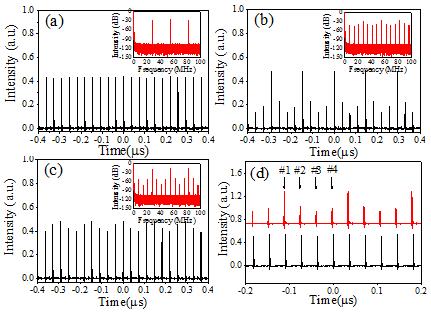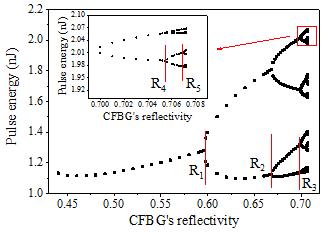Period multiplication is a bifurcation phenomenon, which depicts a typical roadmap from periodic steady-state to chaos. Nonlinear system, whose output is periodic, may go through period bifurcation before its output becomes chaos. Examples could be as simple as droplets’ patterns of a water tap or as complex as discrete-time neural networks. There has been particular interest in studying period multiplication properties in mode-locked lasers, but the mechanism behind is still not well-studied.
Recently, a research team from Shanghai Institute of Optics and Fine Mechanics of the Chinese Academy of Sciences (CAS) experimentally demonstrated a figure-of-9 fiber laser which can generate period-multiplied pulses with long-term stability. According to the authors, the presented laser design could be a stable and reliable ultrafast optical platform to study bifurcation and chaos. The results were published in Optics Express.
Figure-of-9 fiber laser is a new-type of nonlinear amplified loop mirror (NALM) mode-locked fiber laser. In this work, the reported Yb-doped figure-of-9 laser cavity was constructed by entirely polarization maintaining (PM) fibers and PM fiber-pigtailed components. A nonreciprocal phase shifter providing a linear π/2 phase bias was inserted into the NALM loop to promote self-starting of the mode-locked operation.
Researchers found that, by adjusting pump power, the working state of the laser could be switched between fundamental mode-locking and period-quadrupling mode-locking. In contrast with the fundamental mode-locked state, the pulse intensity of the period-quadrupling was no longer uniform, but alternated between four different values, which indicated that steady-state period switched from 1 to 4 round trip times.
Based on the experimental observation, the authors proposed a simplified iteration model to prove that pulse multiplication is a result of overdriving the artificial saturable absorber regardless of pulse formation mechanism. The reliability of the iteration model was also verified experimentally.
Further theoretical insight was obtained by numerical simulations based on the cubic Ginzburg–Landau equation and the split-step Fourier method, which clearly showed that the ratio between the distances of each bifurcation point was approaching the Feigenbaum constant.
The results agree with the classical chaos theory and strongly suggest that the laser design presented here could be a stable and reliable ultrafast optical platform to study bifurcation and chaos.
This work was supported by the National Natural Science Foundation of China.

Fig. 1. Output pulse trains and RF spectra. (Image by SIOM) 
Fig. 2. Bifurcation route map. (Image by SIOM)
Article website:
https://www.osapublishing.org/oe/abstract.cfm?uri=oe-28-12-17424
Contact:
Mr. CAO Yong
General Administrative Office
Shanghai Institute of Optics and Fine Mechanics, CAS
Email: caoyong@siom.ac.cn